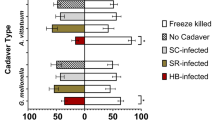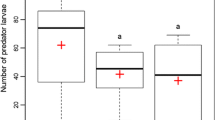Abstract
Many insects repel predators with caustic chemicals, while insects mimicking odors of wastes/dead insects to fool predators have not been documented. We found that the shore earwig, Labidura riparia (Dermaptera: Labiduridae) when bitten by anole lizards, Anolis carolinenesus, spits a rotting-flesh odor that deceives these insectivores into rejecting prey. Once a lizard attacked and rejected an earwig, the lizard did not attack another earwig during several weeks despite consuming other prey, indicating associative learning after one trial. The fetid odor was found in the head-prothorax containing salivary glands of both male and female earwigs and was comprised of ∼100 ng dimethyl disulfide and ∼600 ng dimethyl trisulfide. Nymphs had <5 ng of either compound. Adults also spit odorous sulfides after prolonged attacks by harvester ants, Pogonomyrmex rugosus, who were only deterred by the earwig’s forceps. Sulfides released by the earwig are similar to odors of carrion/feces, which may be innately repulsive to some vertebrate predators. The mean initial discharge percentage (IDP) of sulfides from a cohort of earwigs was 62 %; however, IDPs of individuals were highly variable (3–99 %; mean 57 %). The discharge refill time (DRT) to refill 50 % of the earwig’s allomone reservoir was estimated at 13 h. A positive relationship in sulfide amounts with body weight was found only in females in 2009, suggesting metabolic cost tradeoffs were revealed when sulfide content was half that in 2010. This is the first report of insects releasing sulfur-containing compounds that may mimic carrion-fecal odors as a deceptive defense against vertebrate predators.





Similar content being viewed by others
References
Aihara Y, Yasuoka A, Iwamoto S, Yoshida Y, Misaka T, Abe K (2008) Construction of a taste-blind medaka fish and quantitative assay of its preference-aversion behavior. Genes Brain Behav 7:924–932
Aldrich JR (1988) Chemical ecology of the heteroptera. Ann Rev Entomol 33:211–238
Ammar ED, Farrag SM (1974) Studies on the behaviour and biology of the earwig Labidura riparia Pallas (Derm., Labiduridae). Z Angew Entomol 75:189–196
Armstrong DM, Jones JK Jr (1972) Notiosorex crawfordi. Mamm Species 17:1–5
Baker SE, Ellwood SA, Watkins R, MacDonald DW (2005) Non-lethal control of wildlife: using chemical repellents as feeding deterrents for the European badger Meles meles. J Appl Ecol 42:921–931
Berg JM, Tymoczko JL, Stryer L (2002) Biochemistry. WH Freeman, New York
Blaul B, Ruther J (2012) Body size influences male pheromone signals but not the outcome of contests in Nasonia vitripennis. Anim Behav 84:1557–1563
Brand CJ, Windingstad RM, Siegfried LM, Duncan RM, Cook RM (1988) Avian morbidity and mortality from botulism, aspergillosis, and salmonellosis at Jamaica Bay wildlife refuge, New York, USA. Colonial Waterbirds 11:284–292
Brennan TC, Holycross AT (2006) A field guide to amphibians and reptiles in Arizona. Arizona Game and Fish Department, Phoenix, AZ
Byers JA (2005) A cost of alarm pheromone production in cotton aphids, Aphis gossypii. Naturwissenschaften 92:69–72
Byers JA (2006) Production and predator-induced release of volatile chemicals by the plant bug Lygus hesperus. J Chem Ecol 32:2205–2218
Byers JA (2013) Modeling and regression analysis of semiochemical dose-response curves of insect antennal reception and behavior. J Chem Ecol 39:1081–1089
Byers JA, Levi-Zada A (2011) Individual variation of (S)-4-methyl-3-heptanone in heads of braconid wasp, Leiophron uniformis, and Pogonomyrmex ants indicates costs of semiochemical production. Chemoecology 21:35–44
Cooper WE Jr, Hardegen R (2000) Lingual and biting responses to prey chemicals by ingestively naive scincid lizards: discrimination from control chemicals, time course, and effect of method of stimulus presentation. Chemoecology 10:51–58
Crewe RM, Ross FP (1975) Pheromone biosynthesis: the formation of sulphides by the ant Paltothyreus tarsatus. Insect Biochem 5:839–843
Dugravot S, Thibout E, Abo-Ghalia A, Huignard J (2004) How a specialist and a non-specialist insect cope with dimethyl disulfide produced by Allium porrum. Entomol Exp Appl 113:173–179
Eisner T (1960) Defense mechanisms of arthropods. II. The chemical and mechanical weapons of an earwig. Psyche 67:62–70
Eisner T, Rossini C, Eisner M (2000) Chemical defense of an earwig (Doru taeniatum). Chemoecology 10:81–87
Garber JC, Barbee RW, Bielitzki JT, Clayton LA, Donovan JC, Hendriksen CFM et al (2011) Guide for care and use of laboratory animals. National Academies Press, Washington, DC
Harari AR, Zahavi T, Thiéry D (2011) Fitness cost of pheromone production in signaling female moths. Evolution 65–6:1572–1582
Hile AG, Shan Z, Zhang SZ, Block E (2004) Aversion of European starlings (Sturnus vulgaris) to garlic oil treated granules: Garlic oil as an avian repellent. Garlic oil analysis by nuclear magnetic resonance spectroscopy. J Agric Food Chem 52:2192–2196
Hoffmeister DF (1986) Mammals of Arizona. Univ Arizona Press and Arizona Game Fish Depart 602 pp
Hussain A, Saraiva LR, Ferrero DM, Ahuja G, Krishna VS, Liberles SD, Korshing SI (2013) High-affinity olfactory receptor for the death-associated odor cadaverine. Proc Natl Acad Sci U S A 110:19579–19584
Jaffe K, Mirás B, Cabrera A (2007) Mate selection in the moth Neoleucinodes elegantalis: evidence for a supernormal chemical stimulus in sexual attraction. Anim Behav 73:727–734
Johri PK, Johri R (2012) The description of internal anatomy of Indian earwigs, Labidura riparia form bengalensis (Dohrn), Euborellia annulipes (Lucas) and Nala Lividipes (Dufour): Dermaptera with special reference to digestive, nervous, respiratory, circulatory and reproductive systems. J Exp Zool India 15:309–334
Jürgens A, Wee SL, Shuttleworth A, Johnson SD (2013) Chemical mimicry of insect oviposition sites: a global analysis of convergence in angiosperms. Ecol Let 16:1157–1167
Kobayakawa K, Kobayakawa R, Matsumoto H, Oka Y, Imai T, Ikawa M, Okabe M, Ikeda T, Itohara S, Kikusui T, Mori K, Sakano H (2007) Innate versus learned odour processing in the mouse olfactory bulb. Nature 450:503–508
Langston RL, Powell JA (1975) The Earwigs of California (Order Dermaptera). Bull Calif Insect Survey 20:1-25 Univ Calif Press
Laska M, Metzker K (1998) Food avoidance learning in squirrel monkeys and common marmosets. Learn Mem 5:193–203
Lev-Yadun S, Ne’eman G, Shanas U (2009) A sheep in wolf’s clothing: do carrion and dung odours of flowers not only attract pollinators but also deter herbivores? Bioessays 31:84–88
Lovern MB, Holmes MM, Wade J (2004) The green anole (Anolis carolinensis): a reptilian model for laboratory studies of reproductive morphology and behavior. Inst Lab Anim Res J 45:54–64
Ming QL, Lewis SM (2010) Pheromone production by male Tribolium castaneum (Coleoptera: Tenebrionidae) is influenced by diet quality. J Econ Entomol 103:1915–1919
Moré M, Cocucci AA, Raguso RA (2013) The importance of oligosulfides in the attraction of fly pollinator to the brood-site deceptive species Jaborosa rotacea (Solanaceae). Intern J Plant Sci 174:863–876
Pan H, Lu Y, Wyckhuys KAG (2013) Repellency of dimethyl disulfide to Apolygus lucorum (Meyer-Dür) (Hemiptera: Miridae) under laboratory and field conditions. Crop Prot 50:40–45
Pasteels JM, Grégoire JC, Rowell-Rahier M (1983) The chemical ecology of defense in arthropods. Ann Rev Entomol 28:263–289
Pudil F, Uvira R, Janda V (2014) Volatile compounds in stinkhorn (Phallus impudicus L. ex Pers.) at different stages of growth. Eur Sci J 10:163–171
Radi RC, Linsenmair KE (1991) Maternal behavior and nest recognition in the subsocial earwig Labidura riparia Pallas (Dermaptera: Labiduridae). Ethology 89:287–296
Reed TM, Rocke TE (1992) The role of avian carcasses in botulism epizootics. Wildl Soc Bull 20:175–182
Robbins PS, Crocker RL, Nojima S, Morris BD, Roelofs WL, Villani MG (2003) Methyl 2-(methylthio)benzoate: the unique sulfur-containing sex pheromone of Phyllophaga crinita. Naturwissenschaften 90:517–520
Roggenbuck M, Schnell IB, Blom N, Baelum J, Bertelsen MF, Pontén TS, Sørensen SJ, Gilbert MTP, Graves GR, Hansen LH (2014) The microbiome of new world vultures. Nat Commun 5(5498):1–7
Roper TJ, Marples NM (1997) Odour and colour as cues for taste-avoidance learning in domestic chicks. Anim Behav 53:1241–1250
Rowe AH, Rowe MP (2006) Risk assessment by grasshopper mice (Onychomys spp.) feeding on neurotoxic prey (Centruroides spp.). Anim Behav 71:725–734
Ruberson JR, Herzog GA, Lambert WR, Lewis WJ (1994) Management of the beet armyworm (Lepidoptera: Noctuidae) in cotton: role of natural enemies. Fla Entomol 77:440–453
Schlinger EI, van den Bosch R, Dietrick EJ (1959) Biological notes on the predaceous earwig Labidura riparia (Pallas), a recent immigrant to California (Dermaptera: Labiduridae). J Econ Entomol 52:247–249
Shanbhag BA, Ammanna VHF, Saidapur SK (2010) Associative learning in hatchlings of the lizard Calotes versicolor: taste and colour discrimination. Amphibia-Reptilia 31:475–481
Shepard M, Waddill V, Kloft W (1973) Biology of the predaceous earwig Labidura riparia (Dermaptera: Labiduridae). Ann Entomol Soc Am 66:837–841
Sirugue D, Bonnard O, Le Quere J-L, Farine J-P, Brossut R (1992) 2-Methylthiazolidine and 4-ethylguaiacol, male sex pheromone components of the cockroach, Nauphoeta cinerea (Dictyoptera, Blaberidae): a reinvestigation. J Chem Ecol 18:2261–2276
Sreng L (1990) Seducin, male sex pheromone of the cockroach, Nauphoeta cinerea: isolation, identification, and bioassay. J Chem Ecol 16:2899–2912
Symonds MRE, Johnson TL, Elgar MA (2011) Pheromone production, male abundance, body size, and the evolution of elaborate antennae in moths. Ecol Evol 1:227–246
Urru I, Stensmyr MC, Hansson BS (2011) Pollination by brood-site deception. Phytochemistry 72:1655–1666
Waddill VH (1978) Sexual differences in foraging on corn of adult Labidura riparia (Derm.: Labiduridae). Entomophaga 23:339–342
Acknowledgments
I thank Le Anne Elhoff for technical assistance. Mention of trade names or commercial products in this article is solely for providing specific information and does not imply recommendation or endorsement by the US Department of Agriculture. USDA is an equal opportunity provider and employer.
Data accessibility
Data deposited in figshare repository: http://figshare.com/preview/_preview/1308556
Ethical approval
All applicable international, national, and/or institutional guidelines for the care and use of animals were followed.
Author information
Authors and Affiliations
Corresponding author
Additional information
Communicated by: Sven Thatje
Electronic supplementary material
Rights and permissions
About this article
Cite this article
Byers, J.A. Earwigs (Labidura riparia) mimic rotting-flesh odor to deceive vertebrate predators. Sci Nat 102, 38 (2015). https://doi.org/10.1007/s00114-015-1288-1
Received:
Revised:
Accepted:
Published:
DOI: https://doi.org/10.1007/s00114-015-1288-1





